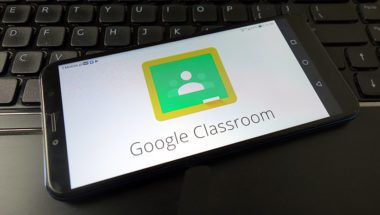Let’s be honest. In normal times, there are plenty of people who think that school librarians just sit around reading books all day. Or worse, they believe that we only stamp books and shush people. Distance learning in the time of COVID hasn’t helped that perception.
I am a middle and high school librarian at an international school in India. When India closed all schools and we went into distance learning, my husband and I relocated to our home in Minnesota to continue teaching. Whenever we’d talk to friends or family, or even some colleagues, I’d hear, “And what do YOU do during distance learning?”, with the implication that as a teacher-librarian outside of her library, I served no purpose.The reality is that during this time of distance learning, I work as much as I do when I’m physically in my library, and I’ve put in more working hours this summer than I ever have. Librarians, with our experience using online platforms, are probably among the educators worldwide who were the most prepared to move to digital schooling.
I often think of my work as falling into four categories: supporting individual students and teachers, supporting classes, managing the library, and participating in school life. All of those things continue, and they all look slightly different when teaching from a distance.
Supporting Individuals
 I don’t think a day has gone by since our physical campus closed that I haven’t answered at least one question from a student, teacher, or parent. Some I can quickly answer: How do I access . . . . ? What’s the password for . . . . ? Do we have a subscription to . . . . ? Some require a little more thought: What should I read next? Can you help me access these resources . . . . ? And others start a much longer conversation: Is . . . . a good research question? How do I teach . . . . ?
I don’t think a day has gone by since our physical campus closed that I haven’t answered at least one question from a student, teacher, or parent. Some I can quickly answer: How do I access . . . . ? What’s the password for . . . . ? Do we have a subscription to . . . . ? Some require a little more thought: What should I read next? Can you help me access these resources . . . . ? And others start a much longer conversation: Is . . . . a good research question? How do I teach . . . . ?
I believe that I get so many questions because of the relationships I’ve developed with my colleagues and students. These are the same kinds of questions I get during a normal, on-campus school day (and in the evenings and on weekends)—sometimes in person, but often in email. I’m thankful that the campus closure happened at the end of my second year at the school, so the students and teachers know me and my ability and willingness to support them, and that they continue to reach out to me.
When the school went to distance learning, approximately half of our students and colleagues stayed in India, where the time difference to Minnesota is 10.5 hours, and the other half are in time zones all over the world. That meant that as soon as I’d wake up in the morning, I’d have an inbox full of messages that I’d try to answer over my morning tea. If I could get to them soon enough, I might be able to answer a student’s question before they went to bed. Additional questions would pop up during the day, from people in a similar time zone to me. At the end of my day, I’d answer another batch of new questions, as students and teachers in different parts of the world were waking or working.
Information literacy skills are more important than ever, and being able to support students and teachers as they navigate so much technology and access information from home is a crucial part of the job.
Supporting Classes
We entered our distance learning phase with very little warning, and I was in the midst of working with classes who were engaged in research projects. The ninth grade students were finishing their history research, and the tenth grade students were just about to begin theirs.  The history, learning support, and EAL teachers and I worked together to take units that would normally take place in the library to an online platform using Google Classroom, Screencastify, and Zoom. We’d plan together, across time zones, using Google Docs. Instead of co-teaching in-person lessons, we would record our Zoom conversations to kick off each day’s work. I was given access to the classes in Google Classroom to give feedback on the students’ work, something I would normally have done in person.
The history, learning support, and EAL teachers and I worked together to take units that would normally take place in the library to an online platform using Google Classroom, Screencastify, and Zoom. We’d plan together, across time zones, using Google Docs. Instead of co-teaching in-person lessons, we would record our Zoom conversations to kick off each day’s work. I was given access to the classes in Google Classroom to give feedback on the students’ work, something I would normally have done in person.
Seventh grade language arts and tenth grade English students were moving into choice reading units as our campus closed, so we brought them all into the library on our last on-campus day and encouraged them to take stacks of books. I worked with teachers to add digital books to our collection to give students more choices as the school closure continued, helped students and teachers learn to access those books, and “met” with individual students, at the student’s or teacher’s request, to help them find their next books.
I worked with teachers to add digital books to our collection to give students more choices as the school closure continued, helped students and teachers learn to access those books, and “met” with individual students, at the student’s or teacher’s request, to help them find their next books.
The grade elevens in the IB Program are tasked with writing the first draft of the Extended Essay (EE) over the summer, so the EE coordinator and I held classes and drop-in sessions to help them work toward that goal. We used Google Forms to gather information about where they are in the process and what support they might need. I sent personal messages offering support to those who indicated they were struggling with their paper or who rated themselves on a self assessment as lacking competency in certain research skills. I’ve fielded dozens of source requests from students as they discover they need additional information.
Managing the Library
Digital resources took on a greater role in teaching and learning once campus closed, and schools around the world were able to benefit from a number of organizations offering their services for free for a limited time. I found myself signing my school up for almost every offer that came our way, but quickly realized that more was not necessarily better. My teachers were being overwhelmed with too many options, and it was important for me to be more careful in the curation of what I suggested for them to try. That required time to dig in and explore some new digital resources, so I could either reject them or make a knowledgeable recommendation to the right teachers.

Modern libraries are a combination of physical and digital spaces. Even though the physical library has been mostly closed to visitors since mid March, it’s still important for us to maintain our physical space and collection. I have a fantastic team of library assistants who have been working mostly from home and occasionally in the library. Purchasing print and digital books, renewing databases, and maintaining the library website and catalog all continue, whether or not we’re on campus. We use Whatsapp to communicate with each other for questions that need immediate responses, and email and Google Docs for longer conversations.
International schools tend to have a relatively large turnover of students, and the number this year will likely be higher than most. Collecting library returns from students who have already left the country, and adding new families to our digital resources have both been areas of focus for our team.
My elementary school librarian colleague and I, both in the U.S., developed a phased library re-opening plan that includes curbside checkout and deliveries to a Delhi suburb, and continue to advertise and coordinate the curbside checkout from afar. We worked with a student and parent to get a Parent Student Association grant to add more books to our eBook collection, and monitor requests via email and a Google Form.
Our physical space is being adapted to accommodate social distancing, so I communicate regularly with the maintenance team on the ground about those accommodations. And, unfortunately, a monsoon rain and a leaky roof have required even more conversations with our maintenance staff. (Whatsapp videos of rain pouring through the library ceiling were not fun to wake up to!)
Participating in School Life
I am a member of two faculties (middle school and high school) and a number of committees and teams that meet regularly, and those gatherings are even more important during distance learning. The meetings are scheduled to manage time zone differences, which means they typically happen early in the morning or late in the evening for me. Same with learning celebrations, student assemblies, and grade-level moving-on ceremonies. The challenges of Zoom that we’ve all experienced are exacerbated when it’s midnight for some participants, mid day for others, and early in the morning for the rest.
To be honest, this is the part of my library life that’s been the hardest to maintain. Most of our community members—no matter where they were in the world or the severity of their lockdown—experienced some level of isolation from friends and colleagues. As teachers felt more isolated and became more focused on their online teaching, they forgot about the library and the support that I could provide. I would inadvertently be left off of mailing lists and left out of meetings and conversations. It’s harder to be visible to my colleagues in a digital world; it’s not as simple as walking into a team room or sitting down with them in the lunchroom. I sometimes would send out all-school messages to highlight library services or offer new resources, but was very aware of the email fatigue that everyone was experiencing; I tried to time messages to provide “just in time” service, but that’s hard to determine without regular contact with people.
The Work Continues
I know how lucky I am. I am privileged to be a teacher-librarian at a school where I am supported by the administration and school community, I have a budget that allows me to acquire appropriate digital resources, and my students have internet access and devices to use those resources. On the other hand, our students face challenges unique to the international schools world. Some don’t know if or when they’ll be allowed to return to their home country or to India, temporarily or permanently. Some are in different countries than their family and friends. Most are working in a different time zone than their peers and teachers. Many are studying in a language that isn’t spoken at home. And like students around the world, my students are struggling to manage the stress, fatigue, and isolation that often go hand in hand with online schooling.
As a teacher-librarian, my job in distance learning is as important as ever, to help my colleagues and students acquire and use the information and technology literacy skills necessary to navigate this new learning environment. I look forward to the day when we can return to campus while continuing to use all of the great technology and information skills we’ve mastered during this challenging time.



